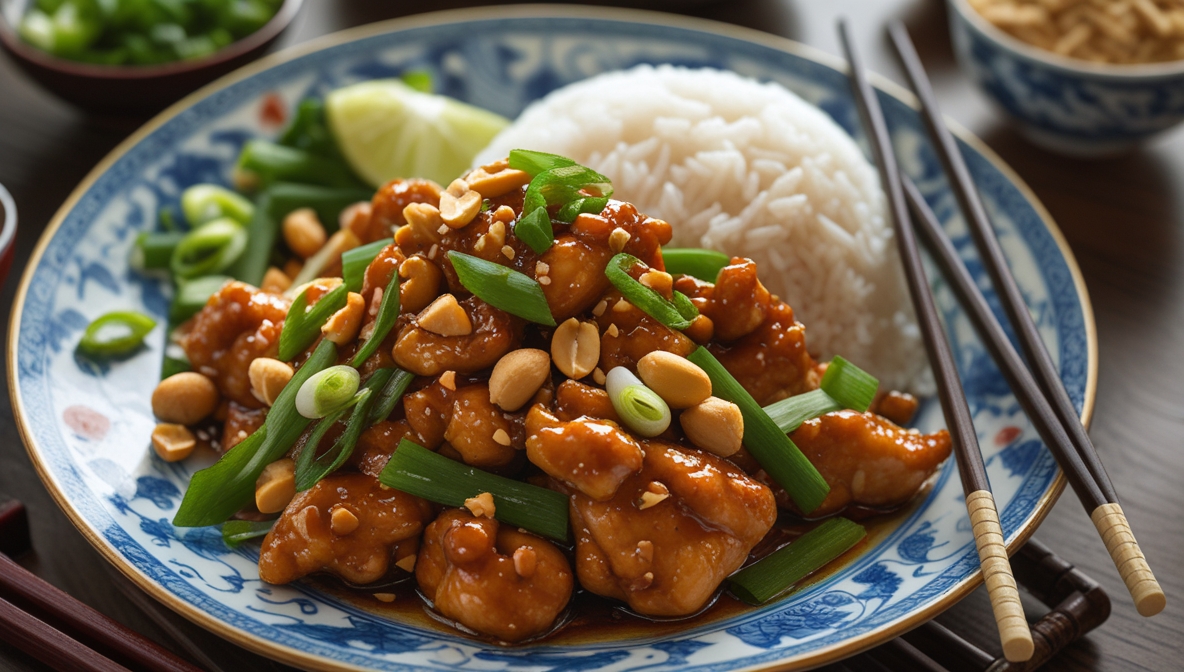Introduction
Kung Pao Chicken (Gong Bao Ji Ding) is one of the most recognizable and beloved dishes from China, especially in Sichuan cuisine. With its tantalizing combination of tender chicken cubes, crunchy peanuts, and bold, spicy sauce, this dish represents a perfect balance of flavor, texture, and heat. Known for its mouth-numbing Sichuan peppercorns and sweet soy glaze, Kung Pao Chicken is as much a culinary delight as it is a cultural symbol.
What makes it so loved? It packs complexity in every bite—sweet, savory, spicy, and nutty. It’s easy to see why Kung Pao Chicken has become a staple in Chinese restaurants worldwide.


History & Cultural Significance
Kung Pao Chicken traces its origins back to the Qing Dynasty. It is said to have been named after Ding Baozhen, a Sichuan governor and “Kung Pao” (a royal court title). Legend has it that he enjoyed a dish of stir-fried chicken with peanuts and chili peppers, and his personal chef popularized it throughout the province.
Culturally, the dish is often associated with home-cooked comfort food in Sichuan households and is a proud representation of the region’s signature spicy cuisine. While not tied directly to festivals, it’s a menu favorite during celebratory meals and family gatherings.
Ingredients & Regional Variations
Key Ingredients:
Diced chicken breast or thigh
Dried red chilies
Sichuan peppercorns
Garlic and ginger
Roasted peanuts
Scallions
Soy sauce, Shaoxing wine, vinegar, and sugar (for sauce)
Regional Variations:
Sichuan Version: The original—fiercely spicy with lots of chilies and peppercorns.
Guizhou Version: Adds fermented black beans for depth.
American-Chinese Version: Often sweeter, with bell peppers and fewer spices.
Modern Twists: Vegan versions use tofu or mushrooms. Some fusion restaurants add cashews or even pineapple for a tropical flair.
Cooking Process & Difficulty Level

Difficulty Level:
Intermediate (requires stir-fry technique and sauce preparation)
Quick Step-by-Step Guide:
-
Marinate chicken in soy sauce, wine, cornstarch.
-
Stir-fry peanuts and set aside.
-
Cook dried chilies and peppercorns in hot oil.
-
Add chicken and stir-fry until nearly done.
-
Add garlic, ginger, scallions.
-
Pour in sauce (soy sauce, vinegar, sugar).
-
Toss in peanuts; stir to coat everything evenly.
Tips:
-
Use high heat and quick stir-fry to keep meat juicy.
-
Toast the Sichuan peppercorns for enhanced aroma.
Where to Eat Kung Pao Chicken in China
Chengdu (Sichuan Province) is the birthplace of authentic Kung Pao Chicken.
Famous Spots:
-
Chen Mapo Tofu Restaurant, Chengdu – Famous for authentic Sichuan dishes.
-
Yu’s Family Kitchen – A Michelin-recommended fine-dining spot in Chengdu.
-
Street Markets in Sichuan – You’ll find incredible versions cooked to order with intense heat and flavor.
Pairing with Drinks & Side Dishes
Best Drink Pairings:
-
Jasmine tea or Pu-erh tea (to balance the heat)
-
Light beers (for a refreshing contrast)
-
Dry Riesling or chilled white wine
Great Side Dishes:
-
Steamed jasmine rice
-
Garlic bok choy
-
Cold sesame noodles
-
Pickled cucumber salad
Fun Facts & Lesser-Known Trivia
-
The dish is named after an actual person: Ding Baozhen.
-
Authentic versions use at least 20+ dried chilies.
-
Sichuan peppercorns aren’t spicy—they’re citrusy and cause a tingling numbness.
-
Kung Pao Chicken is often misspelled as “Kung Pow” in Western countries.
Health Benefits & Nutrition
Nutrition Profile:
-
High in protein from chicken and peanuts
-
Contains healthy fats from nuts and cooking oils
-
Low in carbs if served without rice
Dietary Adaptations:
-
Vegan: Replace chicken with tofu or mushrooms.
-
Gluten-Free: Use tamari instead of soy sauce.
-
Low-Carb/Keto: Skip sugar and pair with cauliflower rice.
How to Cook It at Home (Best Kung Pao Chicken Recipe)
Ingredients:
-
300g chicken breast (diced)
-
1 tbsp soy sauce, 1 tbsp Shaoxing wine, 1 tsp cornstarch (marinade)
-
10 dried red chilies
-
1 tsp Sichuan peppercorns
-
2 cloves garlic (minced), 1 inch ginger (minced)
-
2 scallions (chopped)
-
2 tbsp roasted peanuts
-
Sauce: 1 tbsp soy sauce, 1 tbsp vinegar, 1 tsp sugar
Instructions:
-
Marinate chicken (15 mins).
-
Heat oil, fry chilies and peppercorns.
-
Add chicken, cook until golden.
-
Add garlic, ginger, scallions.
-
Add sauce and peanuts. Toss well.
-
Serve hot over rice.
Flavor Tips:
-
Don’t overcrowd the pan—use a wok for best results.
-
Adjust sugar and vinegar balance for your taste.
Global Influence & Fusion Cuisine
Kung Pao Chicken has become a global icon of Chinese cuisine. In America, it’s often milder and slightly sweeter. In fusion restaurants, you might see Kung Pao Chicken tacos, pizzas, or wraps.
From Thai adaptations with basil to Korean versions with gochujang, the essence of Kung Pao lives on in creative, international forms.
Comparison with Similar Dishes
-
Kung Pao Chicken vs. General Tso’s Chicken: Kung Pao is spicier and nuttier, while General Tso’s is sweeter and breaded.
-
Kung Pao vs. Thai Cashew Chicken: Both are nutty, but Thai version uses cashews and often has bell peppers.

